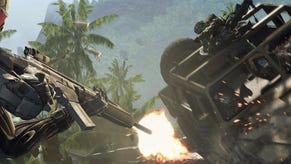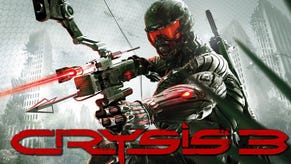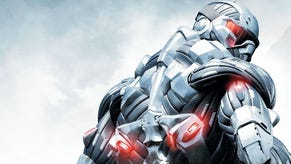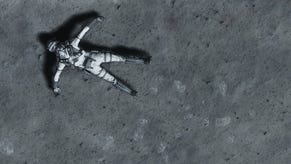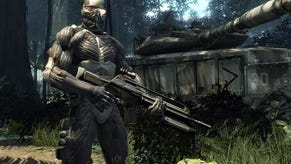Crysis
Muscular Action.
Crysis is filled with these kind of periodic zones of action. Some of them, such as the harbour level, are huge, and you'll find yourself juggling tasks, stealing vehicles to get about, while simultaneously gawping at the huge conflict that occasionally unfolds around you. I played through each of the major areas several times, on a range of difficulty levels. I had a totally different experience each time. Just by taking a slightly different route you'll end up in a fight you hadn't anticipated. Bump the game up to hard and suddenly you're thinking about whether enemy bullets are going to go through the fence you're about to dive behind, or whether you really can rely on grenades to put that machine-gun nest down. Gung-ho action is default on the easier settings, but as the enemy damage output increases with difficulty, you begin to be a little more cautious.
Playing around the with suit's powers, or simply trying to set up the sneakiest, most intricate assaults is awesomely satisfying. Rather like Half-Life 2's sudden expansion of interactive possibilities with the gravity gun, Crysis' suit turns most of the island into a violent playground. You'll find yourself playfully lobbing chickens at enemies one moment, and then savagely hunting them down like some half-invisible monster the next. Hearing your soldier buddy radio in and say "go quietly on this next objective" as you're halfway through the process of driving a Humvee through the roof of a tin shack (just to watch it collapse realistically) has a kind of perverse glory to it. Crysis is bombastic and bold, but caters just as much to stealth and surprise.
In fact the overall story of Crysis almost seems incidental against the backdrop of so many potentially awesome encounters. I'm sure some people will be disappointed by the eventual alien-powered denouement, or mystified or bored by turns as they discover what lies inside the mountain. I'm fairly confident that people will feel slightly uncomfortable with the screeching caricatures that constitute most of the Korean soldiers that you end up butchering, but at least the main sidekick characters aren't annoying. In fact, if I had to give a word to the overall single-player campaign, I would be patchy. There are great highs, such as landing on a ridge at night, under fire from artillery, but also occasional muddles where the pace just cannot maintain and you end up rooting about in sheds looking for ammo, or simply feeling a bit lost, in spite of the green arrow that urges you ever onward.
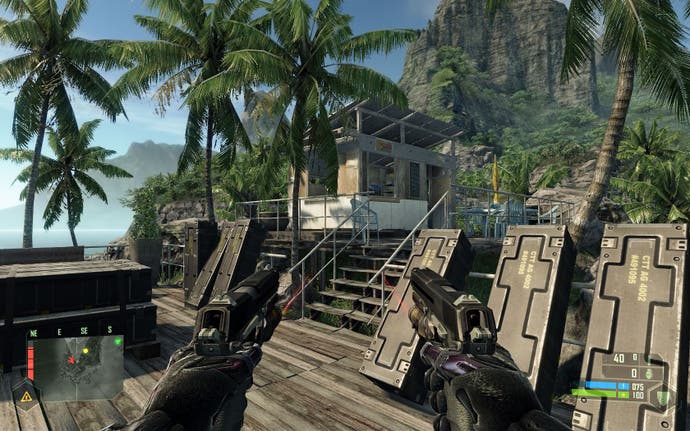
That said, the overall story is far more sprawling and complex than I had expected - with loads of variation in the challenges laid out for you and a bunch of stages of development beyond what I had expected. Even the strictly linear bits don't seem overly predictable, although the flying-squid shooting gallery stuff at the end is (as so many people had speculated) rather less interesting than fighting gangs of human enemies in the first two thirds of the game. The pace and sense of danger at the end of the game is nevertheless commendable - you do feel as if an unstoppable alien menace is stirring. It's almost a shame that they didn't make a little more of the frozen jungle environments that we had seen talked about so enthusiastically in the previews of this game.
There's also a gnawing sense that much of the larger world is lost to you. These huge geographies sometimes seem wasted, since you just end bombing through them, or simply stumbling onwards without finding secondary objectives to pursue. One particular night-time section had me running for ten minutes to get through it - being pursued by a helicopter that I didn't have the firepower (or, more accurately, the inclination) to deal with. Thanks to the ever-replenishing energy reserves of the suit I could basically run for cover and bodge it until I reached the next waypoint.

Naturally there's multiplayer too, with all participants gifted with the hi-tech powers of the nanosuit. This comes in the form of standard deathmatch, and the rather less standard Powerstruggle mode. This mode provides a Battlefield-styled large scale combat in which two teams battling for control of a number of large military facilities. These provide power to central vehicle-production centres which will, eventually, allow either side to create a game-ending vehicle that can be used to destroy the opposing base. Nukes go off pretty much routinely. Crysis' multiplayer is extremely robust and provides a huge, open palette for organised teamwork to create some really interesting tactics - the versatility of the nanosuit sees to that. However, I can't see this multiplayer offering making too much of an impact on the general PC scene. It's too clinical to compete with the heavy-duty franchise-empowered design monsters like Enemy Territory, and too complex to appeal to the rest of PC gaming... (they'll be knee-deep in TF2).

So Crysis is imperfect in a number of ways, but it's nevertheless a stupendously solid game for the PC. It's an FPS that exhibits some of the technological tricks we've been promised over the last few years while still offer a cogent, often thunderous, action-shooter experience. Its incredible looks are perhaps only let down by some of the art direction. It gives us a lavish world, but it's perhaps not applied imaginatively enough. The aliens are a worthy challenge at times, and provide a suitably pumped-up dramatic conclusion, but they never really surprise or inspire the kind of awe that they're presumably intended to. The level design might have been just a little tighter too. I found myself feeling like huge sections of the game had been wasted, and really I just wanted go back and play through the harbour again, or that wooded valley. Perhaps even more significantly, I wanted to see what the complex physics model and destructible scenery might be able to do in a more urban environment. The island wasn't quite enough for me. It needed a proper town, or at least some kind of island resort.
This is a game that feels supremely engineered, like a precision machine, or a German automobile. It makes Half-Life 2 seem old and frail, but by the same token it does nothing to diminish the imaginative achievements of that series. Crysis is impressive, but not imaginatively bold. Nor does it engage us like some other great shooters - such as BioShock - have done with their world and their personality. It's far better than Far Cry, and it's clearly going to create a rabid army of fans, many of whom I hope will plug themselves into the absurdly easy-to-us level editor and create us more single-player campaigns. Personally I'd like to see where this astounding world-forging technology will take us. And I can't wait to see what Crytek will do next.
If you're an FPS-eater of any calibre then you should probably buy Crysis. It's going to run on any machine that will run Half-Life 2, although without a tricked-out DirectX 10-supporting behemoth you're going to miss out on some of the atmospherics.


